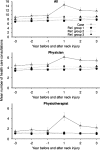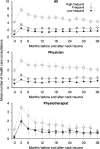Healthcare consultation and sick leave before and after neck injury: a cohort study with matched population-based references
- PMID: 23996819
- PMCID: PMC3758980
- DOI: 10.1136/bmjopen-2013-003172
Healthcare consultation and sick leave before and after neck injury: a cohort study with matched population-based references
Abstract
Objectives: Recent studies based on self-assessed data on exposure and outcome suggest a negative association between poor health before neck injury and recovery. Our aim was to study actual healthcare consultation and work disability before and after neck injury (whiplash).
Design: Cohort study with matched references studied prospectively and retrospectively via regional and national held registers.
Setting: Population-based study in Region Skåne, Sweden (population=1.21 million) including all levels of healthcare.
Participants: 1443 participants aged ≥18 (54% women) with acute neck injury, Whiplash, (International Classification of Diseases-10-SE code S13.4*) in 2007 or 2008 and no such diagnosis since 1998. Each patient with a neck injury was assigned four randomly selected population references matched for age, sex and area of residence (97% of the patients and 94% of the references were followed during the whole study period).
Primary and secondary outcome measures: We studied changes in healthcare consultations 3 years before to 3 years after diagnosis as well as sick leave episodes. Analyses were also stratified by preinjury frequency of consultation.
Results: Before the injury, the mean number of total consultations over 36 months among the neck injured (n=1443) and references (n=5772) was 9.3 vs 7.2 (p<0.0001) and postneck injury 12.7 vs 7.8 (p<0.0001). In the group of high-frequent consulters, there were more women compared with frequent and low-frequent consulters (70.6% vs 32.8%; p<0.0001). Among low-frequent and frequent consulters preinjury (n=967, 67% of the cohort), 16% became high-frequent consulters attributable to the injury. The number of days of sick leave preinjury was correlated with the number of preinjury and postinjury consultations (r=0.47 (99% CI 0.38 to 0.49), r=0.32 (99% CI 0.25 to 0.37)).
Conclusions: People with a neck injury constitute a heterogeneous group. The preinjury level of healthcare consultation is associated with the postinjury level of consultation.
Keywords: EPIDEMIOLOGY; Register; Treatment; Whiplash injury.
Figures






References
-
- Styrke J, Stålnacke B-M, Bylund P-O, et al. A 10-year incidence of acute whiplash injuries after road traffic crashes in a defined population in northern Sweden. P MR 2012;4:739–47 - PubMed
-
- Siegmund GP. What occupant kinematics and neuromuscular responses tell us about whiplash injury. Spine 2011;36:S175–9 - PubMed
-
- Jull G, Kristjansson E, Dall'Alba P. Impairment in the cervical flexors: a comparison of whiplash and insidious onset neck pain patients. Man Ther 2004;9:89–94 - PubMed
-
- Ivancic PC, Panjabi MM, Ito S. Cervical spine loads and intervertebral motions during whiplash. Traffic Inj Prev 2006;7:389–99 - PubMed
-
- Adams MA, Freeman BJ, Morrison HP, et al. Mechanical initiation of intervertebral disc degeneration. Spine 2000;25:1625–36 - PubMed
LinkOut - more resources
Full Text Sources
Other Literature Sources
